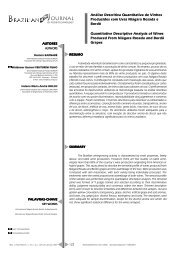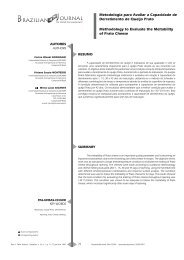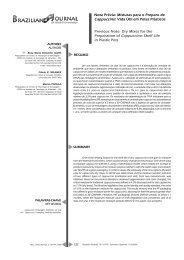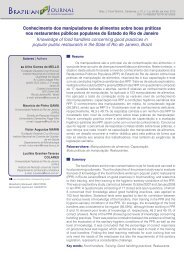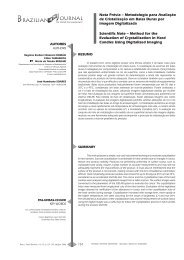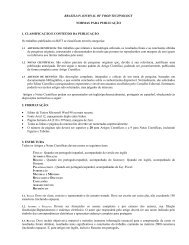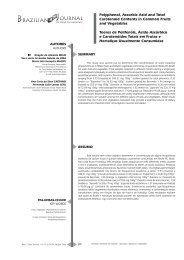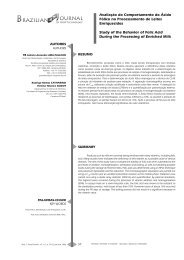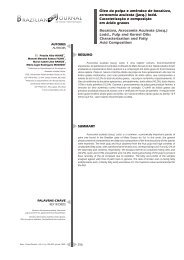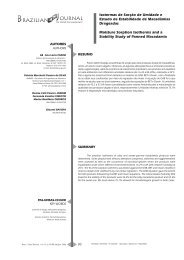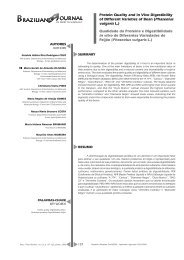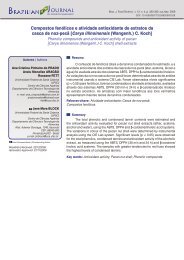Water absorption and mechanical properties of starch foam trays ...
Water absorption and mechanical properties of starch foam trays ...
Water absorption and mechanical properties of starch foam trays ...
Create successful ePaper yourself
Turn your PDF publications into a flip-book with our unique Google optimized e-Paper software.
www.ital.sp.gov.br/bj<strong>Water</strong> <strong>absorption</strong> <strong>and</strong> <strong>mechanical</strong> <strong>properties</strong> <strong>of</strong> <strong>starch</strong> <strong>foam</strong> <strong>trays</strong> impregnated with <strong>starch</strong> acetateSCHIMIDT, V. C. R. <strong>and</strong> LAURINDO, J. B.2.2 Scanning electron microscopy (SEM)Micrographs <strong>of</strong> the <strong>foam</strong> tray samples were obtainedusing a model XL-30 (Philips, Holl<strong>and</strong>) scanning electronmicroscope. Before obtaining the micrographs, the <strong>foam</strong>tray samples were coated with a thin gold layer using amodel SCD 005 (BAL-TEC, Switzerl<strong>and</strong>). All samples wereexamined using an accelerating voltage <strong>of</strong> 20 kV.2.3 Tray water <strong>absorption</strong>A comparative water <strong>absorption</strong> study wasperformed using a modified procedure based on the ABNTNBR NM ISO 535 St<strong>and</strong>ard (1999), which was derivedfrom the Cobb method. It consisted <strong>of</strong> a gravimetricalanalysis in which a sample (with a known dimension <strong>of</strong>25 × 50 mm) was weighed before <strong>and</strong> after immersion indistilled water for 1 min. The water adhered to the samplesurface was removed with absorbent paper.2.4 Measurement <strong>of</strong> the <strong>mechanical</strong> <strong>properties</strong>The <strong>mechanical</strong> <strong>properties</strong> <strong>of</strong> the <strong>foam</strong> <strong>trays</strong> weredetermined using the tensile strength test in accordancewith the ASTM D828-97 st<strong>and</strong>ard test method. Before the<strong>mechanical</strong> tests, the <strong>foam</strong> tray samples were conditionedfor 5 days at ambient temperature (about 25 °C) <strong>and</strong> a relativehumidity <strong>of</strong> 75% (obtained using a saturated solution<strong>of</strong> sodium chloride). The conditioning is important becausethe water absorbed by the materials acts as a plasticizingagent, modifying the material <strong>properties</strong> (SHOGEN et al.,1998; SOYKEABKAEW et al., 2004). The model TA.XT2iTable 1. The conditions used for sample impregnation.SamplecodesStarchacetate/chlor<strong>of</strong>orm(g.mL –1 )Impregnationtime(min)*PressureconditionA = non -- - -impregnated sampleAP, 1:3,05 min 1:3 5 APAP, 1:3,10 min 1:3 10 APAP, 1:3,30 min 1:3 30 APVP, 1:3,10 min 1:3 10 VPAP, 1:5,05 min 1:5 5 APAP, 1:5,10 min 1:5 10 APAP, 1:5,30 min 1:5 30 APVP, 1:5,10 min 1:5 10 VPAP, 1:10,05 min 1:10 5 APAP, 1:10,10 min 1:10 10 APAP, 1:10,30 min 1:10 30 APVP, 1:10,10 min 1:10 10 VP* Pressure condition: AP = atmospheric pressure; <strong>and</strong> VP = vacuumpulses, followed by a period at atmospheric pressure.texture analyser (SMS, Surrey, UK) with the 25 N loadcell was used to determine the <strong>mechanical</strong> <strong>properties</strong> <strong>of</strong>the <strong>foam</strong> tray samples. The tensile strength <strong>and</strong> elongationat break were determined from the tension tests. Inthe tension tests, <strong>foam</strong> tray samples with dimensions <strong>of</strong>25 × 100 mm were fixed to the machine, <strong>and</strong> the testsperformed at 2 mm/s.The force at break <strong>and</strong> relative deformation weredetermined from the puncture tests. The puncturetests were performed using a spherical probe (21 mmdiameter), previously fixed in an annular space with adiameter <strong>of</strong> 80 mm, as sketched in Figure 1. The sphericalsteel probe was built specially for these <strong>mechanical</strong> tests,to avoid sharp edges that could influence the materialbreak. During the tests, the probe was moved throughthe sample, from top to bottom, with a speed <strong>of</strong> 1 mm/s,until 30 mm below the sample level. The load applied was0.5 N <strong>and</strong> the tests were performed with 10 repetions foreach sample. For this test, the relative deformations atbreak were represented by Equation 1.∆d= LDwhere ∆L = the probe vertical shift, from the moment ittouched the sample to the break point; D = diameter <strong>of</strong>sample under test <strong>and</strong> d = relative deformation <strong>of</strong> thesamples at break.2.5 <strong>Water</strong> sorption isothermsThe <strong>foam</strong> tray samples were previously dried <strong>and</strong>conditioned in recipients with different relative humidities(RH = 7 to 90%), obtained using saturated salt solutionsat constant temperature (25 °C). The samples wereSphericalprobeFigure 1. Spherical probe <strong>and</strong> base used to fix the sampleduring the puncture tests.(1)Samplesecuring screwBraz. J. Food Technol., v. 12, n. 1, p. 34-42, jan./mar. 2009 36
www.ital.sp.gov.br/bj<strong>Water</strong> <strong>absorption</strong> <strong>and</strong> <strong>mechanical</strong> <strong>properties</strong> <strong>of</strong> <strong>starch</strong> <strong>foam</strong> <strong>trays</strong> impregnated with <strong>starch</strong> acetateSCHIMIDT, V. C. R. <strong>and</strong> LAURINDO, J. B.40%, compared to the non-impregnated samples. Thiscan be explained by the filling up <strong>of</strong> the porous spacesin the material by <strong>starch</strong> acetate solution <strong>and</strong> by thecoating on the material surface. Figure 8 shows the morehomogeneous <strong>starch</strong> acetate film formed at the materialsurface for VP, 1:3,10 min. Moreover, since <strong>starch</strong> acetateis hydrophobic (LAROTONDA et al., 2005), the impregnatedmaterial became less hygroscopic, contributing toa reduction in water uptake. Similar results were reportedby Larotonda et al. (2003) <strong>and</strong> Matsui et al. (2004).Matsui et al. (2004) reported data obtained withcassava bagasse-Kraft paper composites impregnatedwith <strong>starch</strong> acetate/chlor<strong>of</strong>orm solutions (concentrationsImpregnation conditionVP, 1:3,10 minVP, 1:5,10 minVP, 1:10,10 minAP, 1:3,30 minAP, 1:5,30 minAP, 1:10,30 minAP, 1:3,10 minAP, 1:5,10 minAP, 1:10,10 minAP, 1:3,05 minAP, 1:5,05 minAP, 1:10,05 minnon impregnated34%40%64%63%66%67%69%72%70%72%72%73%60 80 100 120 140 160 180 200 220 240<strong>Water</strong> <strong>absorption</strong> (g.cm 2 )100%Figure 4. Influence <strong>of</strong> impregnation on tray water <strong>absorption</strong>.<strong>of</strong> 1:5 <strong>and</strong> 1:10 (g.mL –1 ), for 5 <strong>and</strong> 10 min). The impregnationdecreased water <strong>absorption</strong> by the material byabout 75%. The water uptake by commercial Kraft paper(75 g.m –2 ) impregnated with <strong>starch</strong> acetate/chlor<strong>of</strong>ormsolution, decreased by 56.4% for the samples impregnatedusing vacuum pulses <strong>and</strong> 11.4% for the samplesimpregnated under atmospheric pressure (LAROTONDAet al., 2003).Shogren et al. (2002) studied the preparation<strong>of</strong> <strong>starch</strong> <strong>foam</strong> <strong>trays</strong> with the addition <strong>of</strong> hydrophobiccompounds to improve the water <strong>absorption</strong> resistance.Trays produced with the addition <strong>of</strong> paraffin wax,vegetable oil, silicone oil, resin, aryl acid ester, citric acid,butane-tetra-carboxylic acid, succinic acid <strong>and</strong> ethyleneglycol resin failed to reduce the water <strong>absorption</strong>. Onlymonoester citrate presented a significant decrease inwater <strong>absorption</strong>.The values obtained for tensile strength <strong>and</strong> elongationat break <strong>of</strong> the impregnated <strong>and</strong> original <strong>foam</strong><strong>trays</strong> are shown in Figures 5a <strong>and</strong> b. The results obtainedwith the impregnated <strong>foam</strong> <strong>trays</strong> were compared withnon-impregnated samples <strong>and</strong> with commercial EPS(exp<strong>and</strong>ed polystyrene) <strong>trays</strong>. Impregnation had a smallinfluence on the <strong>mechanical</strong> <strong>properties</strong> mentioned above.Similar results were reported by Matsui et al. (2004) forcomposites formed from cassava bagasse <strong>and</strong> Kraftpaper, impregnated with <strong>starch</strong> acetate/chlor<strong>of</strong>orm solutions(concentrations <strong>of</strong> 1:5 <strong>and</strong> 1:10 (g.mL –1 ) for 5 <strong>and</strong>10 min). These authors reported that impregnation didnot influence the tensile strength <strong>and</strong> elongation at break<strong>of</strong> the samples. Larotonda et al. (2003) reported thatimpregnation <strong>of</strong> Kraft paper with <strong>starch</strong> acetate/chlor<strong>of</strong>ormsolutions (concentrations <strong>of</strong> 1:5 g.mL –1 ) increasedthe material tensile strength 1.5 times.Tensile strength (MPa)654321aElongation at break (%)2.52.01.51.00.5b0EPSnon impregnatedAP, 1:3,05 minAP, 1:3,10 minAP, 1:3,30 minAP, 1:5,05 minAP, 1:5,10 minAP, 1:5,30 minAP, 1:10,05 minAP, 1:10,10 minAP,1:10,30minVP, 1:3,10 minVP, 1:5,10 minVP, 1:10,10 min0.0EPSnon impregnatedAP, 1:3,05 minAP, 1:3,10 minAP, 1:3,30 minAP, 1:5,05 minAP, 1:5,10 minAP, 1:5,30 minAP, 1:10,05 minAP, 1:10,10 minAP,1:10,30minVP, 1:3,10 minVP, 1:5,10 minVP, 1:10,10 minFigure 5. Foam <strong>trays</strong> impregnated with a <strong>starch</strong> acetate/chlor<strong>of</strong>orm solution: a) Tensile strength; <strong>and</strong> b) Elongation at break.Braz. J. Food Technol., v. 12, n. 1, p. 34-42, jan./mar. 2009 38
www.ital.sp.gov.br/bj<strong>Water</strong> <strong>absorption</strong> <strong>and</strong> <strong>mechanical</strong> <strong>properties</strong> <strong>of</strong> <strong>starch</strong> <strong>foam</strong> <strong>trays</strong> impregnated with <strong>starch</strong> acetateSCHIMIDT, V. C. R. <strong>and</strong> LAURINDO, J. B.Force at break (N)1009080706050403020100EPSnon impregnatedVP, 1:3,10 minVP, 1:5,10 minVP, 1:10,10 minAP, 1:3,05 minAP, 1:5,05 minAP, 1:10,05 minAP, 1:3,10 minAP, 1:5,10 minAP, 1:10,10 minAP, 1:3,30 minAP, 1:5,30 minaAP, 1:10,30 minRelative deformation0.1350.1200.1050.0900.0750.0600.0450.030EPSnon impregnatedVP, 1:3,10 minVP, 1:5,10 minVP, 1:10,10 minAP, 1:3,05 minAP, 1:5,05 minAP, 1:10,05 minAP, 1:3,10 minAP, 1:5,10 minAP, 1:10,10 minAP, 1:3,30 minAP, 1:5,30 minbAP, 1:10,30 minFigure 6. Foam <strong>trays</strong> impregnated with a <strong>starch</strong> acetate/chlor<strong>of</strong>orm solution: a) Force at break, N; <strong>and</strong> b) Relative deformation atbreak, δ.The environmental aspects <strong>of</strong> using chlor<strong>of</strong>orm asthe solvent must be carefully evaluated. For industrial use,it is important to evaluate the residual concentration <strong>of</strong> thissolvent in the <strong>foam</strong> <strong>trays</strong> <strong>and</strong> also find ways to recoverthe chlor<strong>of</strong>orm evaporated during the vacuum pulses(impregnation) <strong>and</strong> <strong>foam</strong> tray drying procedures.The puncture tests results for the impregnated <strong>and</strong>non-impregnated <strong>foam</strong> <strong>trays</strong> are presented in Figures 6a<strong>and</strong> b. In general, the samples impregnated with the moreconcentrated solutions (1:3 <strong>and</strong> 1:5 g.mL –1 ) presentedrelatively less deformation than samples impregnated withthe lower concentration (1:10 g.mL –1 ). This behaviour canbe explained by the greater <strong>starch</strong> acetate impregnationobtained with the more concentrated solutions.Moisture sorption isotherms <strong>of</strong> the impregnated<strong>and</strong> non-impregnated <strong>foam</strong> <strong>trays</strong> are shown in Figure 7.The GAB model fitted the experimental sorption data forthe impregnated <strong>and</strong> non-impregnated samples well. Thevalues for the GAB constants are shown in Table 2. Themoisture content <strong>of</strong> the monomolecular layer was higherfor non-impregnated samples. A plausible explanation forthis result is the coating <strong>of</strong> both the sample surface <strong>and</strong>part <strong>of</strong> its porous space by <strong>starch</strong> acetate, which is hydrophobic(LAROTONDA et al., 2005). Figure 8 shows theSEM micrographs <strong>of</strong> the surface <strong>of</strong> an impregnated <strong>foam</strong>tray, <strong>and</strong> some aspects <strong>of</strong> the thin acetate film that coatthe sample surface can be observed. The film presenteda dense structure, interspersed with cracks, due to thebrittle characteristic <strong>of</strong> <strong>starch</strong> acetate (LAROTONDA et al.,2004, 2005). Similar film coatings were reported by Matsuiet al. (2004) <strong>and</strong> Larotonda et al. (2005).Figure 9 shows micrographs <strong>of</strong> cross-sections <strong>of</strong>the impregnated <strong>foam</strong> <strong>trays</strong>. It is impossible to identify theEquilibrium moisture (gw/gss)0.400.300.200.100.000.00 0.20 0.40 0.60 0.80 1.00GAB Impregnated sampleImpregnated sample<strong>Water</strong> activityTable 2. Values for the GAB constants.Constants Non-impregnatedsampleGAB Non-impregnated sampleNon-impregnated sampleFigure 7. Sorption isotherms for the impregnated <strong>and</strong> nonimpregnated<strong>foam</strong> <strong>trays</strong>.Impregnatedsample(1:10 g.mL –1 )K 0.9613 0.9989Xo 0.0269 0.0168C 17.981 11.574R 2 (Adjusted) GAB 0.9941 0.9645<strong>starch</strong> acetate film inside the structure, but details <strong>of</strong> thefibres <strong>and</strong> calcium carbonate distribution can be seen,as well as the voids formed by the arrangement <strong>of</strong> thematerials formed during the heating process.Braz. J. Food Technol., v. 12, n. 1, p. 34-42, jan./mar. 2009 39
www.ital.sp.gov.br/bj<strong>Water</strong> <strong>absorption</strong> <strong>and</strong> <strong>mechanical</strong> <strong>properties</strong> <strong>of</strong> <strong>starch</strong> <strong>foam</strong> <strong>trays</strong> impregnated with <strong>starch</strong> acetateSCHIMIDT, V. C. R. <strong>and</strong> LAURINDO, J. B.abAcc.V Spot15.0 kV 5.0Magn Det WD250x SE 10.9100 mAcc.V Spot15.0 kV 5.0Magn Det WD250x SE 10.9100 mcdAcc.V Spot15.0 kV 5.0Magn Det WD250x SE 11.0100 mAcc.V Spot15.0 kV 5.0Magn Det WD250x SE 9.815 F100 mFigure 8. SEM micrographs <strong>of</strong> <strong>foam</strong> tray surfaces: a) VP, 1:3,10 min; b) AP, 1:3,10 min; c) AP, 1:5,10 min; <strong>and</strong> d) non-impregnatedsample.abAcc.V Spot15.0 kV 5.0Magn Det WD100x SE 10.9200 mAcc.V Spot15.0 kV 5.0Magn Det WD60x SE 9.8200 mcdAcc.V Spot15.0 kV 5.0Magn Det WD60x SE 9.2200 mAcc.V Spot15.0 kV 5.0Magn Det WD100x SE 10.0200 mFigure 9. SEM micrographs <strong>of</strong> <strong>foam</strong> tray cross-sections: a) VP, 1:3,10 min; b) AP, 1:3,10 min; c) AP, 1:5,10 min; <strong>and</strong> d) nonimpregnatedsample.Braz. J. Food Technol., v. 12, n. 1, p. 34-42, jan./mar. 2009 40
www.ital.sp.gov.br/bj<strong>Water</strong> <strong>absorption</strong> <strong>and</strong> <strong>mechanical</strong> <strong>properties</strong> <strong>of</strong> <strong>starch</strong> <strong>foam</strong> <strong>trays</strong> impregnated with <strong>starch</strong> acetateSCHIMIDT, V. C. R. <strong>and</strong> LAURINDO, J. B.process parameter, structure <strong>and</strong> <strong>properties</strong>. Industrial Crops<strong>and</strong> Products, Amsterdam, v. 16, n. 1, p. 69-79, 2002.SOYKEABKAEW, N.; SUPAPHOL, P.; RUJIRAVANIT, R.Preparation <strong>and</strong> characterization <strong>of</strong> jute <strong>and</strong> flax reinforced<strong>starch</strong>-based composite <strong>foam</strong>s. Carbohydrate Polymers,Kidlington, Oxford, v. 58, n. 1, p. 53-63, 2004.THIEBAUD, S.; ABURTO, J.; ALRIC, I.; BORREDON, E.; BIKIARIS,D.; PRINOS, J.; PANAYIOTOU, C. Properties <strong>of</strong> fatty-acid ester <strong>of</strong><strong>starch</strong> <strong>and</strong> their blends with LDPE. Journal <strong>of</strong> Applied PolymerScience, Hoboken, v. 65, n. 4, p. 705-721, 1997.TIEFENBACHER, K. F. Starch-based <strong>foam</strong> materials: use <strong>and</strong>degradation <strong>properties</strong>. Journal <strong>of</strong> Macromolecular Science:Pure Applied Chemistry, Lowell, v. 30, n. 9-10, p. 727-731,1993.WHISTLER, R. L.; HILBERT, G. E. Mechanical <strong>properties</strong> <strong>of</strong>corn-<strong>starch</strong> <strong>of</strong> film from amylose, amylopectin, <strong>and</strong> whole <strong>starch</strong>triacetates. Industrial & Engineering Chemistry, Washington,v. 36, n. 9, p. 796-798, 1944.WOLFF, I. A.; OLDS, D. W.; HILBERT, G. E. Triesters <strong>of</strong> corn<strong>starch</strong>, amylose, <strong>and</strong> amylopectin. Industrial & EngineeringChemistry, Washington, v. 43, n. 4, p. 911-914, 1951.XU, Y.; HANNA, M. A. Preparation <strong>and</strong> <strong>properties</strong> <strong>of</strong> biodegradable<strong>foam</strong>s from <strong>starch</strong> acetate <strong>and</strong> poly (tetramethylene adipate-coterephthalate).Carbohydrate Polymers, Kidlington, Oxford,v. 59, n. 4, p. 521-529, 2005.Braz. J. Food Technol., v. 12, n. 1, p. 34-42, jan./mar. 2009 42



